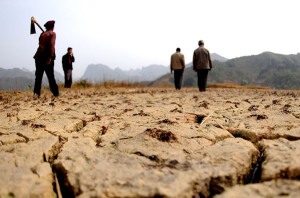North
Korea’s Potential Collapse: An Anthropocene Inferno

23
April, 2017
Tensions
are rising with North Korea. Global security articles tell of
Russian bombers near Alaska, armadas of air craft carriers somewhere
presumably in the Pacific, and satellite imagery of nuclear test
sites showing…volleyball games. If conditions deteriorate, watch
for upwelling warm water off the coast of Chile too, and how warm the
Barents sea is (along with its own armada–of icebergs). Because the
ironic cruelties of the Anthropocene will be every part of North
Korea’s near future as well. And as North Korea disintegrates, so
too does the global relief community.
In
the final days of 2015, Oxfam International warned of “unprecedented
strain”
on the international humanitarian community due to a super El Nino
and the Syrian complex emergency.
To
use a sports analogy, the international relief community stayed in
the playoff picture in North Africa and Eurasia–conducting
operations in Syria, Iraq, and Afghanistan, and managing hundreds of
thousands of migrants attempting to cross the Mediterranean through
Turkey and Libya.
However,
add to this the potential
unraveling of Yemen as
part of the worst humanitarian crisis (including the Horn of Africa
nations) since World War II, the potential resurgence of El Nino, and
a brave new world of extraordinary Arctic amplification…the global
relief community is teetering on the brink of being eliminated from
the playoff picture. That is to say, “playoffs” being an ability
to even remotely plug the holes of governance and support each of
these complex emergencies.
And
like any sports team, when eliminated from the playoffs, it’s time
to go back to the drawing board and rebuild. Time to abandon the
archaic relief operations of the Holocene and at the very least
attempt to come to terms with the climate disruption-catalyzed
Anthropocene.
But
there is no clamoring at the UN or in the NGO community to do this.
No tear up of strategic doctrines of NATO or the strategic interests
of Russia or China.
Perhaps
it is only Turkey that
has even dabbled with humanitarian power projection as a way to
contain the coming disruption beyond sovereign borders. [Ref:
ReliefAnalysis on EurasiaNet]. The global relief community remains
very much an anachronism of the late 20th Century “post Cold War
era”–a game or two from being eliminated with thousands of crises
to go.
North
Korea Would Spectacularly End the Holocene Era of Relief Operations
As
tensions boil with North Korea, the analysis of what
would happens with a regime collapse are clear.
There would be a scramble by Great and Regional powers to secure
the remaining bits of the North Korean nuclear arsenal, likely
involving tense, on-the-ground operations. And the humanitarian
situation would be ghastly. North Korea’s population is 24.3M;
Syria’s is 22.85M. North Korea would hemorrhage displacement and
refugee outflows at least on par Syria. Both complex emergencies
would involve the dangerous engagement of Great Powers (Syria=Russia,
US; North Korea=China, Russia, US) and Regional Powers (Syria=Turkey,
Iran, North Korea=South Korea, Japan) like.
It
is a crude analogy to compare North Korea to Syria, but appropriate
for raw scale. Add another massive complex emergency to Eurasia, and
the global relief community is spectacularly eliminated from being
able to even remotely handle the scale of global disruption. Being
able to respond to West Asia (Syria/Iraq), Central Asia
(Afghanistan), and the greater Horn of Africa (Yemen, Ethiopia,
Somalia, Sudan) simultaneously would be impossible.
Forget
even beginning to think about an emerging El Nino or Arctic
Amplification-induced weather disruption….
The
Cruel Irony of North Korea’s post-Collapse Relief
…Except
here is the kicker. North Korea is particularly vulnerable to both El
Nino andArctic
Amplification.
The
2015 El Nino was North
Korea’s worst drought in
a century, an extraordinary stressor on the 70% of the nation’s
population, which is food insecure. Crop
yields plunged
by 20%, and 25,000 children required immediate treatment fornutrition.
As
the Australian Bureau of Meteorology states in its current El
Nino Watch,
“The pattern of very warm ocean conditions in the far eastern
Pacific but neutral conditions overall is unusual. International
climate models suggest the steady warming of the tropical Pacific
Ocean is likely to continue in the coming months.”
And
in terms of Arctic Amplification, according to published
research in the journal Nature “severe
winters across East Asia are associated with anomalous warmth in the
Barents–Kara Sea region” with “regional warming over the Arctic
Ocean…accompanied by the local development of an anomalous
anticyclone and the downstream development of a mid-latitude trough.
The resulting northerly flow of cold air provides favourable
conditions for severe winters.”
So
in the months ahead, an all-out NGO fracas on the Korean peninsula
could be further punctuated by an El Nino-enhanced drought, and in
winter, a warm Barents-Kara sea could result in a stuck jet
stream and dislodged polar vortex–making winter humanitarian
operations an icy humanitarian hell. [Ref ReliefAnalysis
on UN Dispatch regarding
the challenge of winter operations in Syria.]
Should
North Korea deteriorate, turn on the TV–the global relief community
has just been “officially” eliminated from the playoffs…with an
boundless contests to go.



If I was a North Korean I'd want the bomb.
ReplyDeletehttps://www.facebook.com/WeDemandFreedom/videos/1990321647848806/